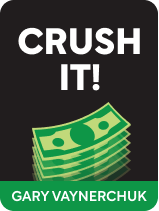

This article is an excerpt from the Shortform book guide to "Crush It!" by Gary Vaynerchuk. Shortform has the world's best summaries and analyses of books you should be reading.
Like this article? Sign up for a free trial here .
Do you want to create a personal brand? What does it take to build an online brand from the ground up?
In his book Crush It!, Gary Vaynerchuk teaches readers how to turn their passions into profits by creating a niche, personal brand. He explains every step of the process in detail so you, too, can do what you love for a living.
Continue below for Gary Vaynerchuk’s eight-step guide from Crush It!.
Step 1: Choose Your Niche
In Crush It!, Gary Vaynerchuk repeatedly argues that your personal brand must be true to who you are—and that starts with your niche. While it’s tempting to choose a topic based on its marketability, he insists that you must let your passion guide you because that will not only resonate with your audience but also keep you motivated and interested in this work during the inevitable long hours and late nights.
(Shortform note: In contrast to Vaynerchuk, Cal Newport argues in So Good They Can’t Ignore You that the idea that following your passion will lead you to love your work is flawed. Instead, he says that the way to find fulfilling work is to hone your skills, and use them as currency to secure a job that gives you autonomy and purpose.)
Vaynerchuk writes that any interest can be fodder for a personal brand—from accounting to carpentry. It may be an extension of your professional expertise, or it may be a hobby, but as long as you’re enthusiastic about it and creative about how you present the information, you will be able to gain digital traction.
Step 2: Establish Your Web Presence
Your website will be the home base for your personal brand; all of your social media posts and outreach should ultimately point people to your website. Vaynerchuk recommends these steps for creating a website:
- Buy your domain name. (Shortform note: Choose a domain name that is short, memorable, easy to spell, and ends with .com.)
- Create a WordPress or Tumblr account to host your domain. (Shortform note: Since the book’s publication, the number of web hosting options has multiplied. When choosing a hosting provider, look for one that offers customer support, allows you to quickly scale your website, and offers reliable security.)
- Hire a web designer, if you can afford it. Although your audience will forgive low-budget production value for your content, a well-designed, user-friendly website will help convert one-time visitors to subscribers. (Shortform note: Website builders like Squarespace and Wix now make it easier to build your own professional-looking website. However, if you want your site to handle complex tasks like certain e-commerce functions, you should hire a web designer—and be prepared to spend several thousand dollars or more.)
- Create your social media accounts. Be sure your username matches your website domain name. (Shortform note: However, if the matching social media handle is unavailable, take heart—research shows that many businesses thrive even when their social media names don’t exactly match their domain.)
Step 3: Choose the Right Medium
Once you know what you’re going to talk about, you must decide how you’re going to present it. When choosing between text, audio, and video, Vaynerchuk suggests basing the choice on your personality and comfort level, rather than the nature of your niche.
- Blogging makes it easy to post daily content, and frequent posting makes it easier for people to find your content. (Shortform note: To increase traffic to your website, HubSpot recommends publishing three to four new posts per week for blogs run by small teams, and four to five new and updated posts per week for blogs with more manpower. And be sure to post on a consistent schedule.)
- Podcasting is ideal for showing your personality and being expressive with your voice if you’re uncomfortable being on camera. (Shortform note: In fact, one podcaster argues that podcasting is perfect for introverts, because they can broadcast their message to the public while still being in the privacy of their own home or office.)
- Video is great for grabbing people’s attention. When your viewers see and hear you, they feel more connected to you, which makes them more invested in your personal brand. (Shortform note: In addition to making your followers feel like they know you, data reveals that video draws more views, shares, and comments than any other type of content on social media.)
Step 4: Choose the Right Platform
Vaynerchuk recommends having multiple platforms. He advises using each one strategically to maximize its strengths, and having them all direct fans back to your blog. (Shortform note: Although he doesn’t clarify, “blog” here seems to refer to either a written blog, vlog, or podcast; Vaynerchuk often refers to written and video “blogs.”) He breaks down the pros and cons of the top platforms of the day, but because much has changed since the book’s publication, we will instead highlight the key features to look for when choosing a platform.
Video
- Livestream with a live chat function enables you to interact with people in real time, which reinforces a powerful sense of connection between you and your viewers. (Shortform note: That may be why research finds that live video holds viewers’ attention eight times longer than pre-recorded video.)
Blogging
- An easy-to-use design enables you to spend more time creating content than figuring out how to post it. (Shortform note: Blogging platforms like Web.com and Wix are user-friendly for content creators who don’t know coding, and some—like WordPress—make it easy to add extra features as your blog grows.)
- A repost feature allows fans to share your content, and their endorsement builds your credibility. (Shortform note: Shares are a highly valued metric in personal branding and social media, but not all shares are created equal—while some shares generate interest in your brand and lead to new followers, others simply create buzz without delivering any returns.)
Social
- Many platforms offer the option to create a business page, which typically has capabilities that are not accessible on your personal profile. (Shortform note: Social media platforms like Facebook and Instagram provide analytics for business pages, but not for personal profiles. Although Vaynerchuk prefers to trust his gut over analytics, others argue that data can help marketers get efficient, effective results.)
- Keyword search helps you tap into your niche community and expand your audience. (Shortform note: Although Vaynerchuk uses the term “keywords,” his advice suggests he may be referring to hashtags, which were introduced on Twitter in 2007, just two years before this book was published. While similar, hashtags and keywords serve different purposes: Hashtags are meant to create buzz and engagement, and keywords—sprinkled strategically throughout your website and blog—drive SEO traffic.)
Step 5: Create Engaging Content
Now that you have the building blocks, it’s time to start creating blogs, Tweets, posts, videos, or podcasts about your topic. Vaynerchuk emphasizes that everything you post is a tool for attracting people to your personal brand and enticing them to become part of your growing audience. (Shortform note: Taking this a step further, when people share and view your content, it boosts your search engine optimization (SEO) score, which makes it easier for people to find you online. This creates a virtuous cycle.)
To make compelling content, Vaynerchuk says you must:
- Be yourself. You won’t be everyone’s cup of tea, but your personality will resonate with some people, and they’ll recognize your authenticity and trust you more for it. Incorporate some personal details and anecdotes to help people get to know you, thereby making them more connected to your brand. (Shortform note: While showing your personality is key to building your personal brand, how much of your personal life you should reveal depends on your topic, your platform, and your comfort level.)
- Keep learning. Continually learn about the topic and stay on top of developments and trends. Read articles, newsletters, trade journals, books, and websites, and attend classes, lectures, and conferences. You can even make content about your learning journey by sharing your discoveries, missteps, and new skills. (Shortform note: Influencers’ popularity is often wrongly equated with expertise. For this reason, it’s important to be transparent about your actual level of expertise to avoid misleading followers.)
- Have plenty to say. Before you start creating content, you should brainstorm at least 50 topics that you’d be excited to blog, vlog, or podcast about. (Shortform note: While Vaynerchuk says you should follow your gut and your passion in choosing your topics—and doing everything else—you can still be strategic in how you select and frame your topics. Think of your ideal audience and present your topics in ways that best help and appeal to them.)
- Tell a good story. Good stories draw people in, keep them coming back for more, and make them want to loop in their friends—and their friends’ friends. Good storytelling can help you grow an audience that attracts sponsors and advertisers.
Step 6: Build Your Community
With good content, you can build the audience you need to be able to monetize your brand. Vaynerchuk notes that, when it comes to creating community, quality beats quantity: A few loyal, engaged fans are likely to draw more followers than a large crowd of passive subscribers. (Shortform note: When it comes time to monetize your brand, many advertisers also recognize the value of quality over quantity. A 2017 report on influencer marketing revealed that “micro-influencers” with narrow niches and devoted audiences of 10,000 to 1 million followers often drive more traction than celebrity endorsements.)
After you’ve created and posted some content, Vaynerchuk provides step-by-step instructions for building your community. Repeat these steps continually to consistently grow your audience.
- Search the keywords for your niche on each social media platform and join active groups and forums related to your topic. (Shortform note: When using keywords, be specific with niche keywords, which are strings of three or more words specific to your niche—for example, instead of searching “fitness,” try “high-intensity cardio workout.” Although this will narrow your search results, it will connect you with a highly targeted audience. For the same reason, be sure to use these niche keywords in your content.)
- Read what people are saying about your topic, what they’re interested in, and what they like and don’t like. This is invaluable data for your own content creation and outreach efforts. (Shortform note: Beyond skimming groups and forums on the social media platforms where you plan to post, you can also search Reddit, set up Google Alerts for your keywords, check Google Trends, use Social Mention, and browse your competitors’ content.)
- Engage in the conversation. Make insightful, knowledgeable comments on content and other comments. Be sure to include your name and a link to your blog, vlog, or podcast. (Shortform note: You can gain even more visibility—and credibility—by writing a guest blog for another brand’s website.)
- Turn your audience into followers with entertaining, insightful content and attention-grabbing call-to-action buttons, like “Subscribe” and “Follow me.” (Shortform note: In Vaynerchuk’s 2013 book, Jab, Jab, Jab, Right Hook, he argues that your content should include a mix of “jabs,” posts that solely entertain and strengthen your connection with your audience, and “right hooks,” which include a call-to-action.)
- Engage with your audience. Show that you recognize and appreciate them by addressing them in your content. You can even include subtle messages and inside jokes that only your loyal fans will pick up on. (Shortform note: Additionally, engaging with your Instagram followers will trigger the algorithm to show them your posts more often.)
Step 7: Keep It Going
You’re well on your way to having a thriving, profitable personal brand—now you just have to keep it up. Vaynerchuk suggests tempering your expectations on several fronts.
- This requires a lot of work. Besides work (if you currently have a job) and quality time with family, Vaynerchuk contends that all of your time should be devoted to creating content, building your community, and maintaining your brand. He says that you should be working late every night, and that your passion for your topic will keep you energized.
- You probably won’t be an overnight success. Don’t get discouraged and lose steam if your audience hasn’t grown much after a few weeks or months. To be successful, you must be consistent. (Shortform note: If you tap out too soon, you’ll miss key moments for growth. For instance, once you’ve posted a few dozen blogs, Google raises your position in search results, which brings more traffic. The exact number of posts is unclear—one source says 20 blogs, another source says 55 to 70.)
- You may not make millions, as some social media stars do. But if you can monetize your brand (using the steps we’ll discuss next) to earn at least as much as your current job pays—while doing something you love and avoiding commutes and office politics—then social media is still a better option. (Shortform note: Exactly how much do social media influencers make? Depending upon several factors—including the number of followers, the platform, the niche, and the type of content—influencers can make anywhere from $2 to more than $25,000 per post.)
Step 8: Monetize
Once you’ve established your credibility and gained an engaged community of followers, you have leverage to start monetizing your passion. These are some ways to earn income through your personal brand.
1) Advertising—Vaynerchuk recommends cold-calling companies that are relevant to your niche and asking them to advertise with you directly. (Shortform note: Some brands will have ready-made content for you to post, while others will want you to create the content. If you have to create the sponsored content, be sure to charge more. )
2) Affiliate programs—Connect with businesses that sell products you believe in, promote their products, and get a commission when people use your link or code to buy the product. (Shortform note: Since you will be representing the brand, expect the company to thoroughly vet you before partnering for an affiliate program. Brands typically want to see that you have a positive reputation and that you have a large following (at least 5,000 on Instagram).)
3) Merchandise—Create your own products with your logo. They can relate to your niche (like resistance bands, if you have a fitness brand) or be promotional (like T-shirts). (Shortform note: Since authenticity is key to online success, selling your own merchandise is better for your brand than selling someone else’s. Alternatively, you could get the best of both worlds by partnering with an existing brand to design a new product or product line.)
4) Speaking engagements—Find a conference on your niche, think of an original theme, and call the organizers to offer a free presentation. Vaynerchuk says you can start charging after you have five or six under your belt, and, in the meantime, you’ll build credibility and gain exposure to an interested audience. (Shortform note: Building on Vaynerchuk’s advice, look locally for your first few speaking gigs—you’re likely to have more contacts in your area, and if it’s unpaid, you’ll minimize your travel expenses. When you land your first gig, leverage it to get more: Ask the organizers to record your presentation so that you can use it to promote yourself as a speaker, and ask them to provide a testimonial.)
5) Seminars—Host events that give you a chance to share your expertise. Be creative and look for opportunities to partner with other entrepreneurs or local businesses—for example, if you have a fitness brand, put on an informational and training session at a local gym. (Shortform note: Seminars have an earnings ceiling—you can only put on so many seminars each month and year. For a more flexible and profitable approach, many influencers are now developing online courses that bottle their personality and knowledge for mass consumption.)
6) Consulting—As you gain followers and credibility, others will start asking you for advice about your niche or on building a following. Charge them for your time and expertise. (Shortform note: Even when consulting, continue to focus on your niche; while you may be an expert at social media branding as a fitness influencer, your skills and tactics may not work for a travel influencer.)
7) Articles—Write articles for blogs, newsletters, and magazines related to your niche. (Shortform note: First, use Buzzsumo to find publications in your niche. Second, gather three to five samples of your writing to show your chops; you can use past blog posts or write new pieces. Then, send samples to the publication’s editors along with a short, straightforward message with your name, niche, and a snapshot of your online presence and credibility.)
8) TV and book deals—When your credibility and notoriety have grown enough, you’ll get opportunities to broadcast your ideas on bigger platforms, as Perez Hilton and Amanda Congdon have. (Shortform note: When it comes to getting a book deal, publishers are concerned more with the quality of your content than the engagement it generates.)

———End of Preview———
Like what you just read? Read the rest of the world's best book summary and analysis of Gary Vaynerchuk's "Crush It!" at Shortform .
Here's what you'll find in our full Crush It! summary :
- Step-by-step instructions for building and monetizing a personal brand
- How to quit your day job and earn a living off your brand
- Why a few loyal followers are better than a crowd of passive subscribers






